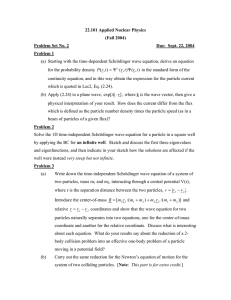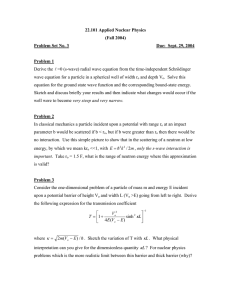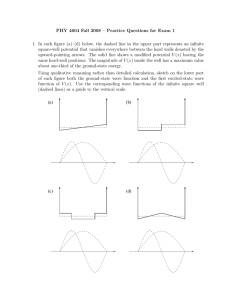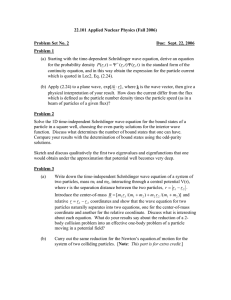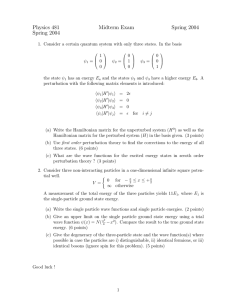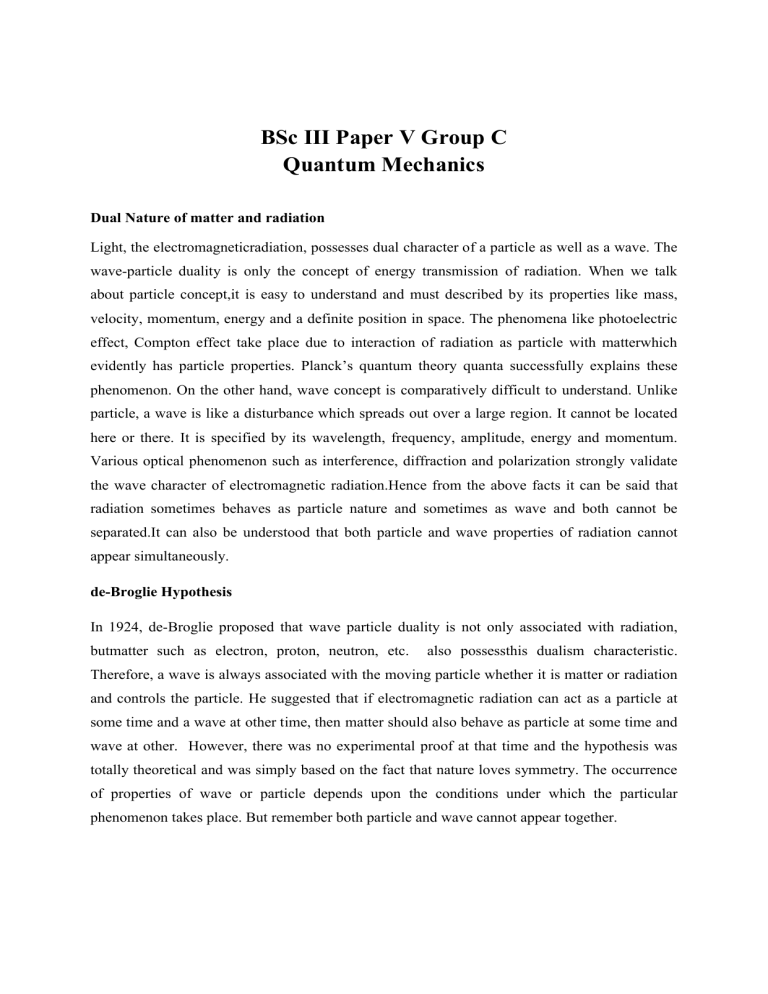
BSc III Paper V Group C Quantum Mechanics Dual Nature of matter and radiation Light, the electromagneticradiation, possesses dual character of a particle as well as a wave. The wave-particle duality is only the concept of energy transmission of radiation. When we talk about particle concept,it is easy to understand and must described by its properties like mass, velocity, momentum, energy and a definite position in space. The phenomena like photoelectric effect, Compton effect take place due to interaction of radiation as particle with matterwhich evidently has particle properties. Planck’s quantum theory quanta successfully explains these phenomenon. On the other hand, wave concept is comparatively difficult to understand. Unlike particle, a wave is like a disturbance which spreads out over a large region. It cannot be located here or there. It is specified by its wavelength, frequency, amplitude, energy and momentum. Various optical phenomenon such as interference, diffraction and polarization strongly validate the wave character of electromagnetic radiation.Hence from the above facts it can be said that radiation sometimes behaves as particle nature and sometimes as wave and both cannot be separated.It can also be understood that both particle and wave properties of radiation cannot appear simultaneously. de-Broglie Hypothesis In 1924, de-Broglie proposed that wave particle duality is not only associated with radiation, butmatter such as electron, proton, neutron, etc. also possessthis dualism characteristic. Therefore, a wave is always associated with the moving particle whether it is matter or radiation and controls the particle. He suggested that if electromagnetic radiation can act as a particle at some time and a wave at other time, then matter should also behave as particle at some time and wave at other. However, there was no experimental proof at that time and the hypothesis was totally theoretical and was simply based on the fact that nature loves symmetry. The occurrence of properties of wave or particle depends upon the conditions under which the particular phenomenon takes place. But remember both particle and wave cannot appear together. According to de-Broglie hypothesis, a particle in motion always has a wave associated with it and the motion of the particle is guided by that wave.These waves are called de-Broglie waves or matter waves.The wavelength of matter waves associated with a moving particle is given by h h p mv h (1) 2mK wherepis the momentum, m is the mass, v is velocity and Kis the kinetic energy of the particle. This relation is true when v<<c. However, when v is comparable to c then relativistic effects come into the picture and hence we cannot take m as the rest mass of the particle, but it will be the relativistic mass and will be given as m m0 1 (v 2 / c 2 ) So, Eq. (1) will take the form h h 1 (v 2 / c 2 ) p m0 v (2) wherem0is the rest mass and cis the velocity of light. Dual Nature of Matter Wave or de-Broglie Wave de-Broglie’s suggestion that with any moving material particle there is a wave associated with it brings the problem of reconciliation of the two seemingly different manifestation of energy, that is, particle having mass which is localized in space and time while waves being massless are delocalized in space and time. The two possible solutions are either to de-localize the particle (no existing theory suggest it) or to localize a wave which is quite plausible using Principle of Superposition which suggests that it is possible to create waves of almost any shape (wave packet) by adding sine waves with properly chosen wave numbers (k), amplitudes and phases. Further, while deriving the expression for velocity of de-Broglie wave, we will show a contradiction and thus led towards the idea that material particle cannot be equivalent to a single wave. Let m be the mass of the particle and v be its velocity.Then h h p mv Also we have, E = mc2 and E = h= mc2/h Matter wave or de-Broglie wave velocity is u = = (mc2/h)(h/mv) = c2/v Clearly for any material particle if v<c, then u>cwhich is highly unexpected.Physically it means de-Broglie wave associated with a particle would travel faster than the particle itself, which indicates that material particle cannot be equivalent to a single wave. Utilizing these above facts, one can visualize how a wave (not a single wave but a wave packet) resembles a particle. In other words, material particle (de-Broglie wave) cannot be equivalent to a single wave, rather it is equivalent to a wave packet. Thus, finally wave packet resembling a particle – group of waves each having slightly different wavelengths, velocities, amplitudes and phases so chosen that they interfere constructively over a small region (localized wave – where the particle can be located) with amplitude and outside of which destructive interference with amplitude reduces to zero (further discussed in Heisenberg uncertainty principle). Wave packets have two velocities: 1.Phase velocity, vp= / k , by which individual wave constituting the packet moves. 2.Group velocity, vg= d / dk , by which the packet itself moves. Clearly since phase velocity vp (earlier u) is always greater than c, it is group velocity by which the particle moves. To showvg = v we have angular frequency 2 2 m c2 h and propagation constant k 2 2 m v h of de-Broglie wave associated with a particle of rest mass m0 and moving with velocity v.We also have m m0 1 (v 2 / c 2 ) Hence, 2 m0 c 2 h 1 (v / c ) 2 2 k and 2 m0 v h 1 (v 2 / c 2 ) Now 2 m0v d 3/2 dv v2 h 1 2 c and 2 m0 dk 3/2 dv v2 h 1 2 c The group velocity is given as 3/2 v2 2 m0 v h 1 2 d d / dv c vg 3/2 dk dk / dv v2 2 m0 h 1 2 c v Thus, a moving particle can be represented by a ‘wave group’ or ‘wave packet’. Finally, the phase velocity vp of the de-Broglie wave associated with a moving particle is given as vp = E E k p p Heisenberg’s Uncertainty Principle Heisenberg in 1927 proposed an uncertainty principle which was direct consequence of dual nature of matter. It is well known that in classical mechanics a particle is described by its definite momentum(velocity) and position. Therefore, its position and velocity (momentum) both can be determined with desired accuracy. However, in quantum mechanics a particle is described by a wave packet moving with group velocity and particle can be located anywhere within the limit of wave packet. Therefore, position of particle in the packet is not certain. Further, the wave packet has a velocity spread; hence, the momentum of particle is also uncertain. For example, if the wave packet is large, the velocity spread is very small and it can be determined accurately, but at the same time the position in such large packet is very uncertain and cannot be determined accurately. On the other hand, when wave packet is small, the position of the particle is almost fixed, but the velocity spread is very large, hence very uncertain. Therefore, certainty in position and in velocity simultaneously is not possible in quantum mechanics. or px (h/2) = (reduced Planck’s constant) The above condition assumes ideal instruments (with unlimited accuracy – not practical) but in practice it is still worse, hence, ‘’ should be replaced by ‘’, that is, x p . Therefore, Heisenberg’s uncertainty principle can be defined as it is impossible to determine the exact position and momentum of a particle simultaneously. Likewise for uncertainty principle for energy and time, we have = (2/T) = (2) = 2 = 2(E/h) using Planck’s Expression Finally we get 2(E/h) t 1 or Eth/2 = Just as above E t . It is not possible to determine both the energy and time co-ordinate of a particle with unlimited precision. Schrödinger Wave Equation Schrödinger, in 1926, for the first time, gave the mathematical formulation to deal with the wave situation existing at the microscopic level, that is, the mathematical description of matter waves. The significance of Schrödinger equation is that it plays the same role in wave mechanics as the Newton’s laws for classical mechanics. Schrödinger equation was formulated as the differential equation for the de-Broglie waves associated with the particles and describes the motion of particles. Schrödinger has developed two wave equations known as time-independent and timedependent Schrödinger wave equations. The applicability of wave equation depends upon the nature of physical problems. Here, we focus on the application of time-independent wave equation such as particle in one-dimensional box. Time-Independent Schrödinger Wave Equation The wave equation is a second-order differential equation whose solution gives the wave disturbances in the medium. The differential equation that can describe any kind of wave motion is given as 2u 1 2u v 2 t 2 Here u is any function and v is the velocity of wave. This equation is capable enough to describe the motion of all types of wave, for example, mechanical waves, EM waves and matter waves. Schrödinger introduced a mathematical function which is the variable quantity associated with the moving particle. It is a complex function of space co-ordinate and time of the particle.is known as wave functionwhich describes the de-Broglie waves associated with the moving particle. So, for de-Broglie waves above equation can be written as 2 (r , t ) 1 2 (r , t ) v2 t 2 The solution of above Eq. is given as ( r , t ) 0 ( r ) e i t Partially differentiating above eqn twice w.r.t.‘t’ we get (r , t ) i 0 ( r )e it t 2 (r , t ) 2 0 (r )e it 2 (r , t ) (2.45) 2 t From Eqs.(43) and (45) we get 2 (r , t ) 2 4 2 ( r , t ) (r , t ) v2 2 2 (r , t ) 4 2 (r , t ) 0 (46) 2 So far we have not used the concept of matter waves. Now to include the concept of matter waves, we put h / mv in Eq and get 2 (r , t ) 4 2 m 2v 2 (r , t ) 0 h2 LetE and V be the total energy and potential energy, respectively.Then the kinetic energy is given by K 1 mv 2 E V m 2 v 2 2 m ( E V ) 2 Putting value of m2v2 in Eq., we get 2 (r , t ) or 8 2 m( E V ) (r , t ) 0 h2 2 (r , t ) 2m( E V ) (r , t ) 0 2 Here h / 2 is known as ‘reduced Planck’s constant’. Time-Dependent Schrödinger Wave Equation For time-dependent Schrödinger wave equation, partially differentiating Eq. (2.44) w.r.t. ‘t’ we get ( r , t ) E E i i 0 ( r )e it i (2 ) 0 ( r )e it 2 i ( r , t ) i ( r , t ) t h i E ( r , t ) i ( r , t ) t Substituting value of E ( r , t ) in time-independent Schrödinger wave equation [Eq. (2.48)], we get 2 (r , t ) 2 ( r , t ) 2 m (r , t ) V (r , t ) 0 i 2 t 2 m ( r , t ) V (r , t ) 0 i 2 t 2 2 (r , t ) ( r , t ) V ( r , t ) i 2m t 2 2 (r , t ) 2m V ( r , t ) i t Above equation is known as ‘time-dependent Schrödinger wave equation’. This equation is used in explaining the non-stationary phenomenon such as electronic transition between two states of an atom. Here [( 2 / 2m) 2 V ] is known as ‘Hamiltonian’ and is denoted by ‘H’. It represents the total energy of the system. i( / t ) is energy operator which when operated on (r , t ) gives the energy. Derivation of Time-Independent Equation from Time-Dependent Equation The time-dependent Schrödinger wave equation is as follows: 2 2 (r , t ) 2 m V ( r , t ) i t For one-dimensionalSchrödinger wave equation is 2 2 V i 2 2m x t Since i( / t ) is energy operator, therefore we can replace it by E. So 2 2 2 2 V E E V 2m x 2 2m x 2 2 2m 2 2m ( ) (E V ) 0 E V x 2 2 x 2 2 This is Schrödinger one-dimensional time-independent wave equation. Physical Interpretation of Wave Function ψ 2 According to Max Born, the square of the magnitude of the wave function, that is, ψ (or ψψ* if ψ is a complex quantity) calculated at a particular point represents the probability of finding the 2 particle at that particular point. ψ is also known as probability density while ψ is called probability amplitude. According to this interpretation, the probability of finding a particle within an arbitrary 2 volume element dτ is ψ dτ. Since the particle will definitely present somewhere within this 2 volume element, therefore the integral of ψ dτ over the entire space must be unity, that is, 2 d 1 . A wave function which satisfies this equation is known as normalized wave function. Applications of Schrödinger Wave Equations Free Particle A particle is said to be free in certain region if its potential energy ‘V’ is zero (V = 0), that is no net force is acting on the particle in that region. For such a region,time-independent Schrödinger wave equation can be written as 2 ( r , t ) 2 m( E V ) (r , t ) 0 2 which reduces intothe following Schrödinger waveequation for free particle: 2 ( r , t ) 2mE (r , t ) 0 2 Let the particle move in positive x-direction [here ( r , t ) is replaced by ( x , t ) ].Without any loss of generality, as the particle is restricted to move only along x-axis keeping y- and z-axis constant, 2 can be reduced to 2/x2 which in this situation is nothing but d2/dx2. Then the wave associated with it can be represented by d 2 ( x, t ) 2mE 2 ( x, t ) 0 dx 2 d 2 ( x, t ) k 2 ( x, t ) 0 2 dx where k 2 2 mE / 2 . The general solution of above Eq is ( x, t ) A eikx B e ikx Here the term A eikx represents the wave travelling in the positive x-direction whereas the term Be ikx represents the wave travelling in the negative x-direction, that is, reflected wave. As the particle is free and there is no boundary by which reflection can take place, so the term Be ikx has no significance. So Eq. reduces to ( x, t ) A eikx This equation is used to describe the wave associated with the free particle moving in positive xdirection. In three dimensions, Eq. can be written as ( x, t ) A e i ( kx x k y y kz z ) A eikr Particle in one-Dimensional Dimensional Infinitely Deep Potential Well(Or (Or Particle in 1D Box) If one-dimensional (1D) motion of particle is assumed to take place in a given region such that its potential energy is zero within this region and infinity at the extremities and outside of this region, then it is described as ‘Particle in 1D 1 Box’. Let a particle of mass mtravel along x-axis axis bouncing back and forth between the walls of the box. The box is supposed to have walls of infinite height at x = 0 and x = L. In terms of boundary conditions imposed by the problem, the potential function is given as V ( x) 0 for x L and x 0 for 0 xL Figure: Particle in a box For such a region time-independent independent Schrödinger Schr dinger wave equation can be written as 2 ( r , t ) which reduces within the box into 2 m( E V ) (r, t ) 0 2 2 ( r , t ) 2mE (r , t ) 0 2 As the particle is within the 1D box [here ( r , t ) is replaced by ( x, t ) , without any loss of generality, as particle is restricted to move only along x-axis keeping y- and z-axes constant, hence, 2 can be reduced to 2/x2 which in this situation is nothing but d2/dx2] then the wave associated with it can be represented by d 2 ( x, t ) 2 m E ( x, t ) 0 dx 2 2 d 2 ( x, t ) k 2 ( x, t ) 0 dx 2 where k2 2mE 2 The general solution of this Eq is given by ( x) Aeikx Be ikx Since the probability of finding the particle is zero at x = 0 and x = L.Therefore, Ψ(x) = 0 at x = 0 which gives A+B = 0 A = –B andΨ(x) = 0 at x = L which gives AeikL Be ikL 0 A(eikL e ikL ) 0 As A ≠ 0, therefore, sinkL = 0 kL = n k n L wheren = 1, 2, 3, …. Putting value of k together with B in Eq. we get n ( x ) A sin n x L 2iAsinkL 0 Energy Eigenvalues we have k2 n 2 2 2mE 2 and k 2 L2 which gives n2 2 2mE = 2 L 2 or En n 2 2 2 2mL2 or En n2 h 2 8mL2 Equation gives the allowed values of energy or the energy eigen values for the particle. From From this equation, we draw following conclusions: 1. We cannot take principal quantum numbern = 0 because for n = 0 we have K = 0 and En = 0 and hence ψ = 0 everywhere in the box. This means that a particle with zero energy cannot be present in the box. In other words, a particle in a box cannot have zero energy. 2. This equation shows that eigenvalues of energy are discrete and not continuous. These values are called energy level of the particle. 3. The lowest energy of the particle is obtained by putting n = 1 in h2 or E1 8mL2 4. En n 2 E1 The spacing betwe n xt high er level increases as en nth energy level and e (n +1)2E1 – n2E1 = (2n+1)E1 Eigenfunction (Normalization of Wave Function) For the region 0 <x<L, the wave function is given by n ( x ) A sin n x L and for the region x ≤ 0 and x ≥ L, the wave function is given by n ( x) 0 The value of constant ‘A’’ can be found out from the normalization condition. Since the total probability of finding the particle within the box is unity, therefore L L * n ( x) n ( x) dx 1 n ( x) dx 1 0 0 1 2n x A 1 cos dx 1 2 L 0 L 2 A2 L 1 2 2 A A2 2 L A2 sin 2 0 n x dx 1 L L L 2n x x 2 n sin L 1 0 2 L Hence the normalized wave function is given by n ( x) 2 n x sin L L Figure3 Energy level diagram The normalized wave functions function for the three states (ψ1, ψ2 and ψ3) together with probability 2 2 densities 1 , 2 , 3 2 are shown in Fig.3. Fig Although ψnmay be positive as well as negative, 2 n is always positive.Since ψn is normalized, its value at a given ‘x’ is equal to the probability 2 density of finding the particle there. In every case, n = 0 at x = 0 and x = L. At a particular place in the box the probability of finding the particle may be very 2 different for different quantum number. For instance, 1 has its maximum value of 2/L in the 2 middle of the box, while 2 = 0 there. A particle in the lowest energy level of n = 1 is most likely to be in the middle of the box, while a particle in the next higher state of n = 2 is never there. Reference: Text book on “ Engineering Physics : Theory and practical”, by Dr. Prof A K Katiyar & C K Pandey published in Wiley India.




